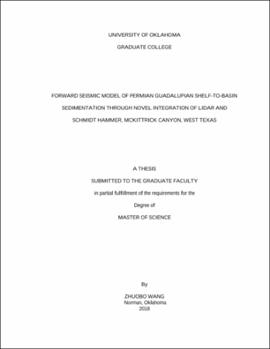| dc.description.abstract | As a result of the challenges occurring with the subsurface seismic interpretation of images of the complicated depositional systems of the Guadalupian of the Permian Basin, forward seismic model is built to guide the subsurface interpretation of a steep-rimmed shelf margin setting and toe-of-slope profile of a prograding reef-rimmed shelf and clinoform exposed on the north wall of McKittrick Canyon of Guadalupe Mountains. This study integrates Light Detection and Ranging (LiDAR), Schmidt hammer and density measurements to craft a seismic analogue.
The stratigraphic frame is established using high-resolution point cloud scanned by RIEGL VZ-400i, containing upper Yates Formation and lower Tansill Formation at the shelf and their equivalent members of Bell Canyon Formation at slope-to-basin section. Three high frequency Late Guadalupian sequences (HFSs) (Tinker, 1998), including Y5, Y6 and T1 are defined in the frame. Slope equivalents of these HFSs are characterized by HST carbonate members with underlying LST bypass siliciclastics, which correlate to the Y5, Y6 and T1 with the McComb Limestone, the McKittrick Canyon Limestone and the Lamar Limestone, respectively. The indirect estimation of P-wave velocity is completed through an empirical relationship between P-wave velocity and Schmidt hammer rebound number (R) and, subsequently, relationship between R and velocity ratio Q (velocity ratio: geomechanical ratio of impact velocity to rebound velocity) which is collected by electric Schmidt hammer applied in this study. Data analysis reveals the heterogeneity of acoustic impedance of each stratum from proximal to distal slope. Deposit-position based trend of impedance variation is discovered by fitting impedance against normalized along-slope distance, which contributes to the impedance model establishment.
A vertical incidence synthetic seismogram is computed upon the geologic model built with LiDAR assisted stratigraphic frame and situ petrophysical information. A zero-phase wavelet of 250 Hz Nyquist are used in the convolution with the reflection coefficient matrix to simulate a seismic profile at study area under ideal conditions. Two additional models are simulated by wavelets of lower band width (125Hz Nyquist) with and without random noise added to establish a comparable profile to general quality seismic data. The first two synthetic seismic profiles show comparable stratigraphic architectures to stratigraphy interpretation on LiDAR while the model simulated by wavelet with band pass of 2, 8, 62.5, 80 Hz exhibits poor resolution and model-induced artifacts.
This investigation shows the potential value of extrapolating an outcrop-based forward seismic model of complicated carbonate in order to provide insight into the subsurface. | en_US |
